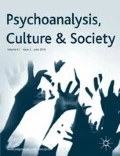Abstract
This paper takes a feminist approach to rethinking the significance of user-device interaction, attachments and dependency. It suggests that Jean Laplanche’s resignification of ‘seduction’, the function of the ‘enigmatic message’ and reconfiguration of sexuality as a ‘charge and tension’ are particularly useful for theorising the relationship that smartphones, as digital objects, have to unconscious sexuality and psychic life. The paper suggests that the draw of user-device interactions is connected to the rhythms of unconscious sexuality and that this opens up a space for thinking beyond subject-object dichotomies and ultimately offers hope for a shift in the cultural imaginary.
Similar content being viewed by others
References
Balick, A. (2013) The Psychodynamics of Social Networking: Connected up Instantaneous Culture and the Self. London: Karnac Books.
Baraitser, L. (2009) Maternal Encounters: The Ethics of Interruption. London: Routledge.
Battersby, C. (1998) The Phenomenal Woman: Feminist Metaphysics and the Patterns of Identity. Oxford: Polity Press.
Benjamin, J. (1998) Shadow of the Other: Intersubjectivity and Gender in Psychoanalysis. New York: Routledge.
Benjamin, J. (2013) What mothers and babies need: The maternal third and its presence in clinical work. In: S.F. Brown (ed.) What do Mothers Want? Developmental Perspectives, Clinical Challenges. Hillsdale: The Analytic Press, pp. 37–54.
Bion, W. (1959) Attacks on linking. International Journal of Psychoanalysis 40: 308–15.
Butler, J. (2005) Giving an Account of Oneself. New York: Fordham University Press.
Evans, D. (2005) An Introductory Dictionary of Lacanian Psychoanalysis. London: Routledge.
Fletcher, J. and Ray, N. (eds) (2014) Seductions and Enigmas: Laplanche, Theory, Culture. London: Lawrence and Wishart.
Freud, S. (1905/1953) Three Essays on the Theory of Sexuality. Standard Edition 7. London: Hogarth Press, pp. 135–243.
Freud, S. (1920/1955) Beyond the Pleasure Principle. Standard Edition 18. London: Hogarth Press, pp. 7–64.
Giles, F. (2018) Making breastfeeding social: The role of brelfies in breastfeeding’s burgeoning publics. In: S. Dowling, D. Pontin and K. Boyer (eds) Social Experiences of Breastfeeding: Building Bridges between Research, Policy and Practice. Bristol: Policy Press, pp. 187–204.
Grosz, E. (1989) Sexual Subversions: Three French Feminists. London: Unwin Hyman.
Irigaray, L. (1985) This Sex Which is Not One. Translated by C. Porter. New York: Cornell University Press.
Irigaray, L. (1993) Sexes and Genealogies. Translated by G.C. Gill. New York: Columbia University Press.
Irigaray, L. (2019) Sharing the Fire: Outline of a Dialectics of Sensitivity. Basingstoke: Palgrave Macmillan.
Jacobs, A. (2015) The demise of the analogue mind: Digital primal fantasies and the technologies of loss-less-ness. In: S. Frosh (ed.) Psychosocial Imaginaries: Perspectives on Temporality, Subjectivities and Activism. Basingstoke: Palgrave Macmillan, pp. 126–144.
Jacobs, A. (2007) On Matricide: Myth, Psychoanalysis, and the Law of the Mother. New York: Columbia University Press.
Klein, M. (1935) A contribution to the psychogenesis of manic depressive states. International Journal of Psycho-Analysis 16: 145–74.
Klein, M. (1952/1987) On observing the behaviour of young infants. In: Envy and Gratitude and Other Works, 1946–1963. London: Hogarth Press, pp. 94–121.
Kristeva, J. and Goldhammer, A. (1985) Stabat mater. Poetics Today 6(1/2): 133–52.
Laplanche, J. (1989) New Foundations for Psychoanalysis. Translated by D. Macey. Oxford: Basil Blackwell.
Laplanche, J. (1992) Jean Laplanche: Seduction, Translation, Drives: A Dossier. London: Institute of Contemporary Arts.
Laplanche, J. (1997) The theory of seduction and the problem of the other. International Journal of Psycho-Analysis 78(4): 653–66.
Laplanche, J. (1999) Essays on Otherness. London: Routledge.
Laplanche, J. (2007) Gender, sex, and the sexual. Studies in Gender and Sexuality 8(2): 201–19.
Macrury, I.M. & Yates, C. (2016) Framing the mobile phone: The psychopathologies of an everyday object. CM: Communication and Media 11(38): 41–70.
Mowlabocus, S. (2016) The ‘mastery’ of the swipe: Smartphones, transitional objects and interstitial time. First Monday 21(10). https://doi.org/10.5210/fm.v21i10.6950.
Nasio, J.D. (1998) Five Lessons on the Psychoanalytic Theory of Jacques Lacan. New York: SUNY Press.
Pollock, G. (2009) Mother trouble: The maternal feminine in phallic and feminist theory in relation to Bracha Ettinger’s elaboration of matrixial ethics/aesthetics. Studies in the Maternal 1(1). https://doi.org/10.16995/sim.114.
Russell, L. (2013) Elsewhere after the flood: Glitch feminism and the genesis of a glitch body politic. Rhizome. https://rhizome.org/editorial/2013/mar/12/glitch-body-politic/, accessed 1 March 2021.
Stein, R. (1998) The enigmatic dimension of sexual experience: The “otherness” of sexuality and primal seduction. Psychoanalytic Quarterly 67(4): 594–625.
Stein, R. (2007) Moments in Laplanche’s theory of seduction. Studies in Gender and Sexuality 8(2): 177–200.
Stone, A. (2012) Feminism, Psychoanalysis and Maternal Subjectivity. Abingdon: Routledge.
Tugwell, S. (2019) Breastfeeding selfies as relational practice: Becoming a maternal subject in the digital age: A single case study. International Breastfeeding Journal 14(1). https://doi.org/10.1186/s13006-019-0218-9.
Van Cleaf, K. (2017) Our mothers have always been machines: The conflation of media and motherhood. In: J. Daniels, K. Gregory and T. McMillan Cottom (eds) Digital Bodies. Bristol: Policy Press, pp. 136–51.
Winnicott, D.W. (1953) Transitional objects and transitional phenomena: A study of the first not-me possession. International Journal of Psycho-Analysis 34(2): 89–97.
Young, I.M. (1990) Throwing like a Girl and Other Essays in Feminist Philosophy and Social Theory. Bloomington: Indiana University Press.
Author information
Authors and Affiliations
Corresponding author
Additional information
Publisher's Note
Springer Nature remains neutral with regard to jurisdictional claims in published maps and institutional affiliations.
Rights and permissions
About this article
Cite this article
Tugwell, S. What lurks beneath: The erotic charge of the Laplanchean unconscious and the digital object. Psychoanal Cult Soc 26, 165–180 (2021). https://doi.org/10.1057/s41282-021-00216-6
Published:
Issue Date:
DOI: https://doi.org/10.1057/s41282-021-00216-6




